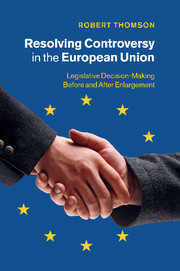 Resolving Controversy in the European Union
Resolving Controversy in the European Union Book contents
- Frontmatter
- Contents
- Figures
- Tables
- Acknowledgements
- 1 Introducing the political system of the European Union
- 2 Research design: measuring controversy spatially
- Part I Inputs
- Part II Processes
- Part III Outputs
- 12 Evaluating and improving the European Union
- Appendix The selection of legislative proposals
- References
- Index
1 - Introducing the political system of the European Union
Published online by Cambridge University Press: 07 October 2011
- Frontmatter
- Contents
- Figures
- Tables
- Acknowledgements
- 1 Introducing the political system of the European Union
- 2 Research design: measuring controversy spatially
- Part I Inputs
- Part II Processes
- Part III Outputs
- 12 Evaluating and improving the European Union
- Appendix The selection of legislative proposals
- References
- Index
Summary
Diversity and controversy in the European Union
Decision makers in the European Union (EU) constantly disagree with one another, yet they usually find ways of resolving their disagreements by taking decisions. These decisions have significant and sometimes unwelcome consequences for citizens. Member states vehemently disagreed on important institutional reforms set out in the Lisbon Treaty that came into force in December 2009. EU member states are diverse in terms of their population sizes. As a result, they have different views on the appropriate weighting of large and small states in the voting system of the Council of Ministers where countries are represented. This controversial issue was raised in the Constitutional Convention that was charged with designing a new set of rules for governing the EU. Despite the long discussions held in the Constitutional Convention between February 2002 and July 2003, talks among member states’ governments collapsed on this issue in December 2003. Representatives of Poland and Spain were among those who wanted to keep the existing rules that gave substantial voting weights to small and medium-sized member states. The French and German governments were among those in favour of reform that would give more voting power to large states. The disagreement was resolved with an amended version of the Franco-German proposal that made some concessions to meet the concerns of smaller countries. This deal was set out in the constitution signed by EU leaders in Rome in October 2004.
But this controversy re-emerged after French and Dutch voters rejected the constitution in national referendums in May and June 2005. A period of reflection followed during the next 18 months. Then the German government called for a resumption of the institutional reform process. Under the stewardship of the German government, the constitution was repackaged as a treaty that contained most of the same reforms, but dispensed with the symbols of a constitution such as the flag and anthem. The advantage of the treaty form from the perspective of EU leaders was that it did not legally require a referendum in most member states. During this repackaging of the constitution as a treaty, the Polish government argued that the reform of member states’ voting rights should be revisited. Tensions rose as the Polish prime minister, Jaroslaw Kaczynski, accused Germany of trying to dominate its smaller neighbours, and recalled that Germany had done so violently in Europe’s troubled past. The Czech government was sympathetic to the Polish argument, but most other member states were reluctant to revisit the issue. The controversy was resolved by revising the proposed voting system again. EU leaders postponed the new system of voting until 2014, introduced a new transition period until 2017 and introduced a new power of delay for minorities of states that were outvoted on issues of national interest. After a marathon round of talks in which this and other controversies were resolved, the late Polish president, Lech Kaczynski, said ‘the one who wins in these kinds of situations is the one with the strongest nerves’. The treaty was then signed by EU leaders in Lisbon in December 2007, and became known as the Lisbon Treaty.
- Type
- Chapter
- Information
- Resolving Controversy in the European UnionLegislative Decision-Making before and after Enlargement, pp. 1 - 20Publisher: Cambridge University PressPrint publication year: 2011


